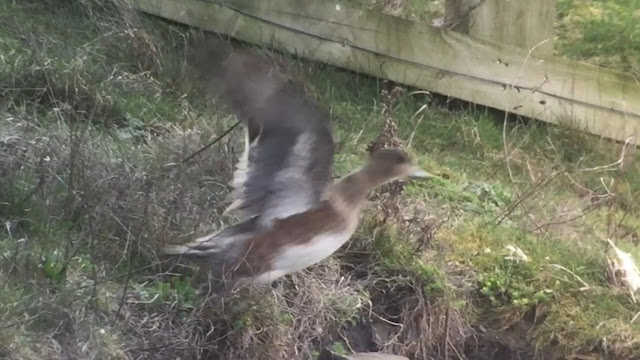Excellent paper on Iberian ID originally published in BB avaliable here
Bird 1
9th & 10th April, Crown Car park, Singing and calling constantly. Quite a dull bird overall. Trapped & Ringed and feathers taken for DNA testing.
Song
Seemingly classic, with 3 different 'phrases' used in alternating fashion, as described in THE BB paper, ‘djup djup djup wheep wheep chittichittichittichitta’. Sometimes just djup and wheep, sometimes, djup and chitti, sometimes wheep and chitti.
Recording here
None of its song phrase lasted for longer than 3.5 sec (Ibe always < 4 and often < 3) with most being around 2.5 sec. All song phrases recorded were 7kHz or below.
Calls
This bird was calling a lot between singing, virtually all of the calls I recorded are the same, between 0.16-0.19 sec long and have a frequency range of 5.7-3.3 kHz.
The classic Iberian, down slurred call, with a slight convex shape to them.
Plumage
Quite a dull Iberian, with more brown tones than usual greenish tones on mantle and wings, but otherwise, lacking an obvious eyering but slightly more prominent on the lower half than bird 2, orange first 3/4 to lower mandible, darker upper, more yellow in the first half of the super, dark brown 'red wine' coloured legs, much cleaner white underneath than Common Chiffchaff. This bird was more similar to Chiffchaff in the field than bird 2 and had us scratching our heads when we caught it!
In field photos © Martin Standley
Bird 2
16th April. Canal Zone, calling a fair bit and tiny bit of subsong. Very bright bird. Trapped & Ringed and feathers taken for DNA testing.
Calls
Bird was frequently calling and was how it was first found/identified.
Link to this birds calls here https://soundcloud.com/timmyjones1234/iberian-chiffchaff-no2-calls
Most of the recordings of this birds calls last around 0.13-0.15 sec, and have a frequency range of 5.7-3.7 kHz
Aberrant? calls
The first call on the above Sound Cloud link looks like this on a Sonogram
To my eyes this seems to have a very steep decline compared to the other calls this bird was giving and the 1st bird gave, with a slight kink at the end of the call, it also sounds a bit more chippy than the more slurred sounds to the other calls. Is this within variation of Iberian calls? The first slope part lasts for 0.04 sec and including the kink 0.09 sec, much shorter than its other calls. Its frequency range is 6.1-3.3 kHz
Another odd call is the following
This call has a slightly different shape to the others, with a kink in the downward slope, it also lasts for 0.11 sec very slightly shorter than the other calls, it has a frequency range of 5.7-3.2 kHz. This call is given around 58 sec into the above Sound Cloud link.
Some calls on Xeno-canto do show a slight kink in similar to this one just not as pronounced, so presumably within variation and it only did it once?
What these two calls do match though is the notes in the below sub song, so a sub-sub song of just one note?
Sub-song
This is quite confusing! Seems to do some good Iberian, djup notes, but then a lot of the below notes that seem to be chiffs and chaffs, it does 2 of the 'diagnostic' up-slurred Iberian notes.
Recording avaliable here
Most of them last for around 2.8 sec with 1 lasting 3.7 sec and the longest being the 'plastic' song at 45 sec in lasting 4 sec.
A frequency range of 6.2-3.4 kHz
Opinion seemed to be that this was just sub-song and the calls and plumage meant it still fit within range of Iberian?
Plumage
Much brighter than bird 1, lacking an obvious eye ring, lots of orange on lower mandible with only really a dark tip, darker upper, much yellow in the first half of the super, greenish toned mantle and wing fringes, dark brown 'red wine' coloured legs, plenty of yellow tones around the wing joint and upper breast, much cleaner white underneath than Common Chiffchaff. Very much more similar to Willow Warbler in the field than Common Chiffchaff.
In hand photo © Paul French


















































